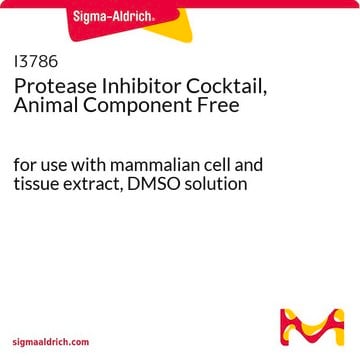P8215
Protease Inhibitor Cocktail
DMSO solution, for the inhibition of serine, cysteine, aspartic and metalloproteases, for use with fungal and yeast extracts, DMSO solution
Synonym(s):
Protease Inhibitor Mix, Protease inhibitor
About This Item
Recommended Products
product name
Protease Inhibitor Cocktail, for use with fungal and yeast extracts, DMSO solution
Quality Level
form
DMSO solution
storage temp.
−20°C
Looking for similar products? Visit Product Comparison Guide
Related Categories
General description
Specificity
Application
- FA buffer to wash spheroplasts to obtain an average DNA fragment size for chromatin immunoprecipitation (chip)
- potassium phosphate buffer (pbs) to digest chitin
- extraction buffer for grinding powdered mycelia for co-immunoprecipitation analysis
Features and Benefits
- Broad specificity: inhibits a wide range of proteases, providing comprehensive protection to fungal and yeast extracts.
- Tested on Saccharomyces cerevisiae cells: the cocktail has been optimized for use on this commonly studied yeast strain.
- Convenient packaging: available in a 1 or 5 mL glass bottle for easy handling and storage.
- Ready-to-use solution: the cocktail is supplied in DMSO solution for immediate use in protease inhibition assays.
- Effective inhibition: each component in the cocktail has been carefully selected for its specific inhibitory properties, ensuring reliable and consistent results.
Components
E-64, 1.4 mM
Pepstatin A, 2.2 mM
1,10-Phenanthroline, 500 mM
Other Notes
Quantity
Physical form
related product
Signal Word
Warning
Hazard Statements
Precautionary Statements
Hazard Classifications
Acute Tox. 4 Oral - Aquatic Acute 1 - Aquatic Chronic 1 - Eye Irrit. 2 - Skin Irrit. 2
Storage Class Code
10 - Combustible liquids
WGK
WGK 3
Flash Point(F)
188.6 °F
Flash Point(C)
87 °C
Certificates of Analysis (COA)
Search for Certificates of Analysis (COA) by entering the products Lot/Batch Number. Lot and Batch Numbers can be found on a product’s label following the words ‘Lot’ or ‘Batch’.
Already Own This Product?
Find documentation for the products that you have recently purchased in the Document Library.
Customers Also Viewed
Related Content
Select different protease inhibitor types based on your needs to prevent protein degradation during isolation and characterization and safeguard proteins in sample prep.
Select different protease inhibitor types based on your needs to prevent protein degradation during isolation and characterization and safeguard proteins in sample prep.
Select different protease inhibitor types based on your needs to prevent protein degradation during isolation and characterization and safeguard proteins in sample prep.
Select different protease inhibitor types based on your needs to prevent protein degradation during isolation and characterization and safeguard proteins in sample prep.
Our team of scientists has experience in all areas of research including Life Science, Material Science, Chemical Synthesis, Chromatography, Analytical and many others.
Contact Technical Service












